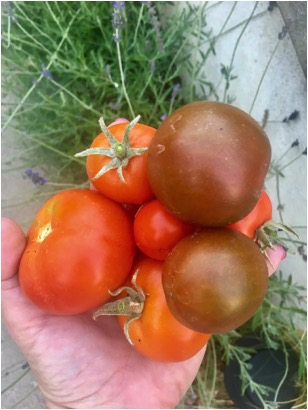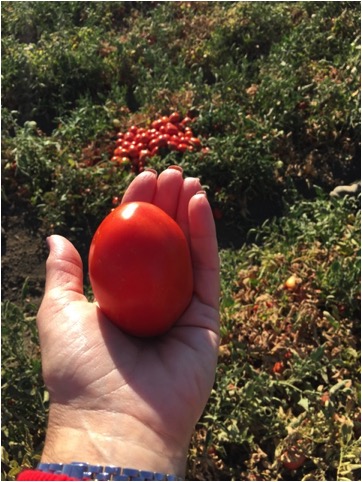Fresh or Canned Tomatoes: How do you choose? Use this guide to help determine when it’s the right time to use canned or fresh tomatoes.

The first batch of fresh heirloom tomatoes from my garden.
With summer quickly approaching, fresh fruits and vegetables are delicious and in season, adding a boost of flavor and texture to some of your favorite summer dishes, from salads to sandwiches and beyond. Tomatoes pack many beneficial health compounds, such as fiber and vitamins A and C, promoting a healthy heart, as well as eyes, skin, and gums. Tomatoes also contain a powerful antioxidant and pigment called lycopene, which lends tomatoes their bright red color and contributes to heart health and cancer prevention.
Though summer’s bounty brings a landslide of tomatoes, from backyard gardens and farmers market to your local supermarket, how do you know when it’s the best time to choose fresh or canned? Follow this guide for inspiration.
Fresh Tomatoes
Tomatoes like to grow in the sunny, hot months of the year. Though they may be available year round, often fresh tomatoes are shipped over long distances in the winter or grown in heated greenhouses. It can take up to two weeks from field to fork to get fresh tomatoes when they are out of season. That’s why winter tomatoes don’t hold a light to summer, vine-ripened tomatoes. Fresh tomatoes can definitely add a flavorful bite to many dishes, such as salads, fresh salsas, bruschetta, sandwiches, and wraps. So, make the most of fresh tomatoes while they are in season. However, if you don’t have a garden and have to purchase fresh tomatoes, you might want to reserve fresh for dishes in which fresh really makes a difference, such as salads and sandwiches. There’s no need to use fresh in dishes that feature cooked tomatoes, such as casseroles and soups.
Canned Tomatoes
Canned tomatoes are harvested at their flavor and nutrition peak and canned within just a few hours. At a very reasonable price, this form of tomatoes can be a budget-friendly, easy, and convenient option–no washing or chopping required. Canned tomato products still contain their original nutrients; while the vitamin C level may be a bit lower, their lycopene is even more bioavailable because of the cooking process.
Canned tomatoes offer a variety of forms already prepared and ready to go, such as tomato sauce, tomato paste, marinara sauce, salsa, and diced, stewed and whole tomatoes. These products give a higher concentration of flavor, which makes them a wonderful choice for dishes such as soups, stews, pasta sauces, pizza, and dips. Since fresh tomatoes can cost more–especially during the fall/winter/spring–you’re probably best off using canned tomato products for dishes in which the texture of fresh isn’t that important, such as pasta dishes, pizza, curry, soups, stews, and casseroles.
Tomatoes: Canned vs. Fresh Guide
Use this guide to help determine when it’s the right time to use canned or fresh tomatoes.
| |
Fresh |
Canned |
| Cost |
1.98 per pound, on vine organic* |
.98 per 14.4oz can diced tomatoes** |
| Local Seasonality (U.S.) |
Summer |
Harvesting during the summer; available year-round |
| Flavor |
Firm, plump, juicy, mild |
Higher concentration of flavor similar or sometimes better than fresh tomatoes based on variety of tomato used and processing procedures |
| Cooking Suitability |
SaladsRoasted
Grilled
Baked
Kebabs
|
SoupsPastas
Salsas
Pizzas
Baked pasta dishes
Marinades
Chili
Curries
Stews
Sauces
Salsas
|
| Convenience |
Wash, slice, and dice as needed |
Open can/jar and mix into dishes |
| *Based on price data, May 25, 2017, Walmart.com**Based on price data for Hunt’s, May 24, 2017, Walmart.com |





Recent Comments